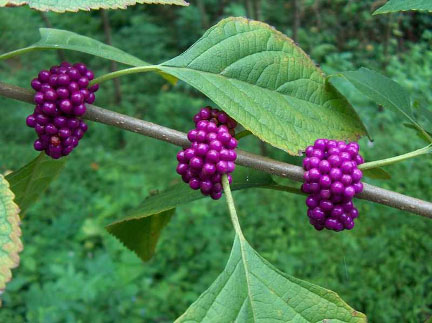Callicarpa americana: American Beautyberry
 Latin name: Callicarpa americana
Latin name: Callicarpa americana
Common name: American Beautyberry
Flowers: Blue, pink or purple/lavender flowers that are >1 inch in size, bloom in cymes in June-August 13,12
Fruit or cones: Showy clusters of glossy purple/white drupes 13
Height & Width: 3-5’ x 3-6’ 13
Type: Deciduous 13,10
Habit: Weeping 7
Wetland indicator category**: FACU 17
Texture: Medium 13
Growth rate: Medium 13
Light: Full sun, part-shade or shade 13,12
Moisture: Medium 12
Soil*: Clay, sandy or loam soil 10, acidic-slightly alkaline pH (4.8-7.0) 16,19
Zones: 7-11 7
Origin: Southeast United States 16
Ecosystem benefits: Food for wildlife 16, attracts pollinators 10
Features: Tough multi-stemmed southeastern US native shrub that is disease, pest and fire resistant 12. Flowers grow on new growth in the spring surrounding the branch adding color to the landscape but may be insignificant if not grown in full sun 12,13. The purple (sometimes white) fruit that emerges in clusters in late summer is showy, provides food for wildlife and can add winter interest after foliage has fallen 12.
Siting: Can be planted as screening or used in mass plantings such as a wildlife or pollinator garden 7. The pH requirements are 4.8 to 7.0 16 and can be planted in full sun to full shade so it also does well in adding color to understory areas and under shade trees in the landscape 10.
Care: Plant so root flare is visible at soil surface 14. At planting, water the root ball daily with two gallons of water per inch of trunk diameter for two weeks, every other day for two months and then weekly until established. Modify water recommendations to reflect site drainage and rainfall. Apply 3” of mulch over the planted area. Do not allow mulch to touch the trunk 14. Can be pruned to 12” above the base to encourage more compact growth, flowering and fruit or left without pruning to mature into a tall woody shurb 10.
Pests: Plants are relatively pest resistant if cultural preferences are met 7.
This plant does not appear on the following invasive plant lists on 2/12/2020:
USDA SC Invasive Plant Species
SC Exotic Plant Pest Council
Author: Michael Henry Franks
Image source: Missouri Botanical Garden (http://www.missouribotanicalgarden.org/PlantFinder/FullImageDisplay.aspx?documentid=14814)
Sources:
- Armitage, A. (2001). Armitage’s manual of annuals, biennials, and half-hardy perennials. Portland, OR: Timber Press.
- Armitage, A. (2006). Armitage’s native plants for North American gardens. Portland, Oregon: Timber Press.
- Armitage, A. (2008). Herbaceous perennial plants: A treatise on their identification, culture, and garden attributes. Athens, GA: University of Georgia.
- Clemson Cooperative Extension Home and Garden Information Center.(2011). Flowers fact sheets. Retrieved from https://hgic.clemson.edu/category/flowers/
- Clemson Cooperative Extension Home and Garden Information Center.(2011). Groundcovers & vines fact sheets. Retrieved from https://hgic.clemson.edu/category/groundcovers/
- Clemson Cooperative Extension Home and Garden Information Center.(2011). Trees. Retrieved from https://hgic.clemson.edu/category/trees/
- Clemson Cooperative Extension Home and Garden Information Center.(2011). Shrubs. Retrieved from https://hgic.clemson.edu/category/shrubs/
- Dirr, M. A. (2009). Manual of woody landscape plants. Champaign, IL: Stipes Publishing.
- Gilman, E. F. (1997). Trees for urban and suburban landscapes. Albany, NY: Delmar Publishers.
- Lady Bird Johnson Wildflower Center University of Texas at Austin. (2012). Native plant information network. Retrieved from http://www.wildflower.org/explore/
- McMillan, P., Plant taxonomist Clemson University, personal communication.
- Missouri Botanical Garden Kemper Center for Home Gardening. Plant finder. Retrieved from http://www.mobot.org/gardeninghelp/plantfinder/Alpha.asp
- North Carolina State University (2005). Plant fact sheets. Retrieved from http://www.ces.ncsu.edu/depts/hort/consumer/factsheets/index.html
- Strother, E. V., Ham, D. L., Gilland, L. (2003) Urban tree species guide: Choosing the right tree for the right place. Columbia, SC: South Carolina Forestry Commission.
- University of Florida, IFAS Extension. (2011). Southern trees fact sheet. Retrieved from http://edis.ifas.ufl.edu/department_envhort-trees
- USDA . Plant profile. (n/d).Retrieved from http://plants.usda.gov/java/
- USDA. Plant wetland indicator status. (n/d). Retrieved from http://plants.usda.gov/wetland.html
- Vincent, E., Environmental horticulturist Clemson University, personal communication.
- Clemson Extension. Carolina Yards Plant Database. Retrieved from https://www.clemson.edu/extension/carolinayards/plant-database/index.htm
*Soil pH is determined using a professional soil test. Contact your Clemson University County Extension service for assistance www.clemson.edu/extension/. Click on “local offices”.
**2012 Plant Wetland Indicator categories (quantitative derived) http://plants.usda.gov/wetinfo.html
| Indicator Code | Indicator Status | Comment |
|---|---|---|
| OBL | Obligate Wetland | Almost always is a hydrophyte, rarely in uplands |
| FACW | Facultative Wetland | Usually is a hydrophyte but occasionally found in uplands |
| FAC | Facultative | Commonly occurs as either a hydrophyte or non-hydrophyte |
| FACU | Facultative Upland | Occasionally is a hydrophyte but usually occurs in uplands |
| UPL | Obligate Upland | Rarely is a hydrophyte, almost always in uplands |
